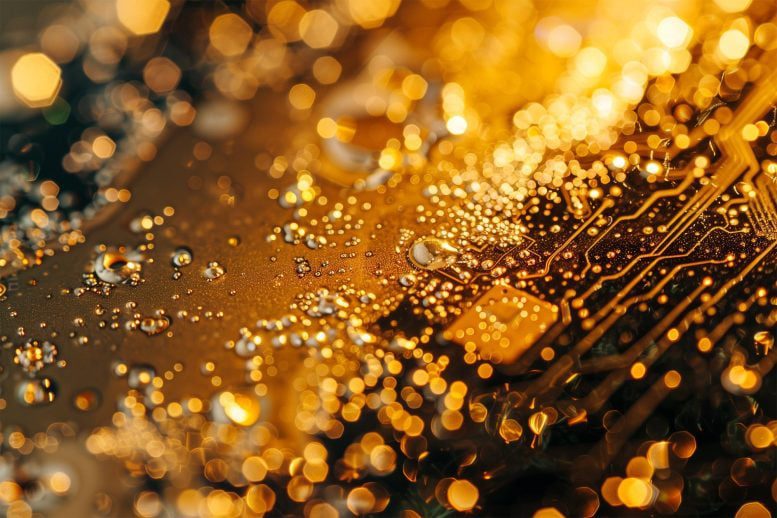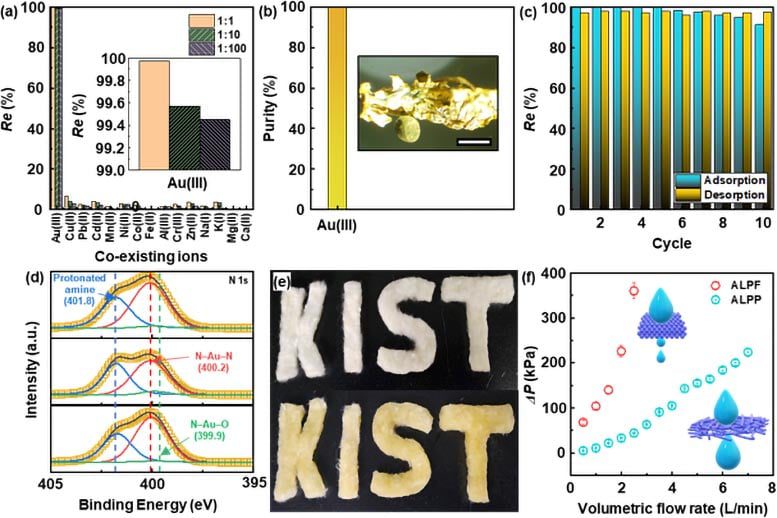
Scientists at KIST have created a fiber-based adsorbent that can retrieve gold from electronic waste with more than 99.9% effectiveness. Source: SciTechDaily.com
A special adsorbent made of fibers collects high-quality gold from waste, making the recovery process cheaper and faster. This also allows for mass production and repeated recycling of the material.
Korea depends on imports for most of its metal resources. As a result, there is growing interest in recycling waste metal resources, known as 'circular resources,' due to resource depletion and increasing raw material costs.
SK hynix and Samsung Electronics are taking steps to increase the amount of copper and gold recovered and reused from semiconductor manufacturing waste. The global circular economy market is expected to double in size by 2026, reaching approximately $712 billion.

This image shows the preparation and physical characteristics of the aminated polyacrylonitrile fibers (PANFs). It includes various details about the fibers and their adsorption capacity for Au(III) ions. Source: Korea Institute of Science and Technology
Groundbreaking Progress in Metal Recovery Technology
In this situation, a group led by Dr. Jae-Woo Choi from the Water Resource Cycle Research Center at the Korea Institute of Science and Technology (KIST) stated that they have created a method for selectively obtaining highly pure gold from electronic waste containing different metals using textile materials.
Typically, adsorbents used for metal recovery are granular in shape to maximize adsorption efficiency, but they can be hard to manage underwater and may lead to low recovery rates and environmental contamination. On the other hand, fiber-based materials are easier to control underwater and can be shaped in various ways, making them suitable for industrial use. However, they are often fragile when used in gold recovery due to their thinness and low strength.

This figure illustrates the performance of ALPF in gold recovery, including the effect of pH on recovery, as well as images and patterns related to the recovery process. Source: Korea Institute of Science and Technology
Improved Methods for Getting More Gold Back
Scientists at KIST have chemically attached alkaline molecules to the surface of polyacrylonitrile (PANF) fibers to enhance the performance and stability of recovering gold at a molecular level. The polymer fiber with amine content has a much larger surface area, which can enhance the capability of attracting gold ions in waste by up to 2.5 times (from 576 mg/g to 1,462 mg/g) compared to the team’s previously developed granular gold adsorption material.
The developed fibrous adsorbent not only demonstrated a gold recovery effectiveness of more than 99.9% in solutions obtained from leaching real CPUs, but also achieved a gold recovery efficiency close to 100% across a wide range of pH 1-4, which includes most waste liquids. It is particularly notable that only gold ions can be separated with a high purity of over 99.9%, even in the presence of 14 other metal ions coexisting in the solution. Furthermore, the gold recovery rate remained at 91% even after 10 uses, showing excellent reusability.

Figure 3. Use of the ALPF adsorbent for Gold Recovery Processes. (a) The ALPF's preference for Au(III) when other metal ions are present, including Cu(II), Pb(II), Cd(II), Mn(II), Ni(II), Co(II), Fe(II), Al(III), Cr(III), Zn(II), Na(I), K(I), Mg(II), and Ca(II). The concentration of Au(III) was set to 10 mg/L, and that of other metal ions was set to 10, 100, and 1000 mg/L. The solution pH was adjusted to 1. (b) The purity of the recovered Au(0) by the ALPF. The inset shows a microscopic image of the recovered Au(0). (c) Tests for repetitive adsorption/desorption of Au(III) using the ALPF adsorbent. The concentration of Au(III) was set to 10 mg/L. The adsorption process was carried out for 24 hours. The solution pH was adjusted to 1. The desorption process was carried out for 24 hours using 0.5 acidic thiourea solution in 1.0 M HCl. (d) Deconvoluted HRXPS spectra of the ALPF for N 1s, indicating the chemical change of amine groups in the ALPF adsorbent during repetitive adsorption-desorption cycles. (e) Photo of felts made of PANF (top) and ALPF (bottom), showing that the fibrous adsorbent can be shaped as required. The scale bar is 2 cm. (f) The impact of adsorbent shapes on the pressure drop in a column filled with the adsorbents. Each pressure drop in the column filled with the adsorbents was measured based on the volumetric flow rate. Credit: Korea Institute of Science and Technology
Final Thoughts and Future Prospects
“The fiber-type adsorbent developed by KIST can help reduce Korea’s reliance on resource imports and prepare for the possibility of increasing raw material prices by enabling effective and environmentally friendly recovery of metal resources,” said Dr. Jae-Woo Choi. “We intend to broaden the scope of future research to selectively recover various target metals in addition to gold,” noted Dr. Youngkyun Jung.
Reference: “Efficient and selective gold recovery using amine-laden polymeric fibers synthesized by a steric hindrance strategy” by Youngkyun Jung, Su-Jin Yoon, Kyung-Won Jung and Jae-Woo Choi, 12 February 2024, Chemical Engineering Journal.
DOI: 10.1016/j.cej.2024.149602



